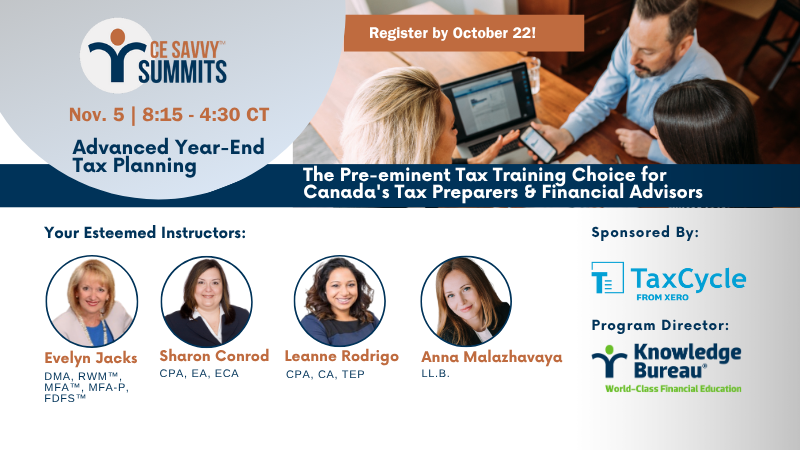Last updated: October 28 2025
Employment Insurance: Beware the CRA May Want it Back

Ruth Horst
The federal government announced changes to the Employment Insurance (EI) regime on October 27, a pre-cursor to their upcoming November 4 budget. Knowledge Bureau will cover the details in a Special Report available to subscribers and in the comprehensive professional CE/CPD training for professional tax accountants and financial advisors on November 5 (earn up to 20 CE/CPD Credits before year end). Registration for the live virtual event is now open. Here’s what you need to know about the EI proposals:
What’s New? The government has announced temporary EI measures in the form of
income supports for Canadian workers whose jobs have been impacted by foreign
tariffs. These supports are expected to cost $3.6 billion over three years. This support
comes in several measures, announced previously in September as part of a reskilling
and support packages, and again in early October. These new measures are worth
exploring with clients. They can include important features such as:
- the waiting period will be waived for all new claims for EI benefits that start between March 30, 2025 and April 11, 2026.
- earnings due to separation from employment (vacation pay, severance, sick leave credits, etc.) will not be deducted from benefits
- long tenured employees will receive 20 weeks of additional EI pay for a total of up to 65 weeks
- certain regions will have unemployment benefit rates adjusted upward
The Clawback Backdrop: In Canada, we have a strong safety net for individuals who find themselves unemployed through no fault of their own. Regular Employment Insurance (EI) benefits provide weekly payments equal to 55% of a recipient’s average insurable weekly earnings, up to a maximum of $695 per week in 2025, for a period of up to 45 weeks. The exact benefit amount also depends on the region of Canada where the claimant resides.
Statistics Canada reports that as of October 19, 2025:
- 571,530 individuals are currently collecting regular EI
- 5,680 were first-time recipients
- $13.26 billion was paid to recipients since April 1, 2025
- $8.21 billion was paid to regular EI recipients
Unemployment numbers increased throughout the first six months of the year, then leveled off during the summer before beginning to rise again in the fall. The current unemployment rate stands at 7.1%. However, these figures only reflect individuals receiving EI benefits and do not include those who have exhausted their EI entitlement but remain unemployed.
September data show that 60,000 new jobs were created, primarily in the manufacturing, healthcare and social assistance, and agriculture sectors. However, during the same period, 21,000 jobs were lost in the wholesale and retail trade sector.
Recent news of companies closing due to the economic downturn or relocating operations outside of Canada has contributed to an increase in the number of Employment Insurance (EI) recipients.
Tax Consequences: Employees who suddenly find themselves jobless or laid off for an indefinite period often rely on EI benefits while searching for new employment. In some cases, severance packages can provide much-needed financial relief but may also create complications at tax time.
Did you know that if your income exceeds a certain threshold, you may be required to repay a portion of the EI benefits you received?
This repayment rule applies only to recipients of regular EI benefits who have collected regular EI within the past 10 years. For the 2025 tax year, individuals who earn more than $82,125 and have collected EI during that period must repay 30% of the income exceeding the threshold. For 2026 that clawback threshold will rise to $86,125.
For example, Stanley was laid off from his job in August. His adjusted net income (Line 23400) for the year was $88,125. He received $10,000 from EI and Box 7 of the T4E has 30% in it. Stanley will need to pay back $1,800.
Line 23400 $88,125
Threshold - $82,125
$ 6,000 x 30% = $1,800
This will add $1,800 to Line 43500 (Tax Payable)
Let’s say that Stanley also received a $30,000 severance package which increased his adjusted net income to $118,125. In this case he will need to repay all of the EI he received.
Line 23400 $118,125
Threshold - $ 82,125
$ 36,000 x 30% = $10,800 (maximum $10,000)
This, combined with the fact that EI rarely withholds enough tax, may leave many recipients facing an unexpected balance owing at tax time.
For all other EI recipients (regular benefits with a 0% repayment rate, caregiving, maternity/parental), be aware that usually only 10% tax is withheld. This might be sufficient in a year where there is little other income but for those with a well-paying job for half the year and EI benefits for the second half, they need to be prepared for a balance owing at tax time.
What can be done? Advisors need to discuss this with their higher earning clients who are facing layoffs immediately and co-ordinate investment opportunities with financial advisors with a view to reducing net income on the tax return. The goal is to preserve all the EI benefits paid, if possible.
The Bottom Line: Many taxpayers experience little variation in their tax returns from year to  year, particularly when they remain with the same employer. However, in a year marked by significant changes—especially when Employment Insurance (EI) benefits are involved—it becomes crucial to engage in proactive tax planning as the year end approaches.
year, particularly when they remain with the same employer. However, in a year marked by significant changes—especially when Employment Insurance (EI) benefits are involved—it becomes crucial to engage in proactive tax planning as the year end approaches.
If a severance package is received and RRSP contribution room is available, a sound strategy may involve contributing the severance amount to an RRSP to take advantage of the tax deduction, even if funds are later withdrawn monthly. In addition, if the taxpayer qualifies, a FHSA (First Home Savings Account) investment can provide tax benefits and savings for a home at the same time. Discuss the qualifiers for those who are eligible.
In short, year end tax planning is focused on one key matter for employees: remain mindful of net income thresholds to avoid unexpected surprises at tax time.
https://www.canada.ca/en/employment-social-development/programs/ei/statistics.html
